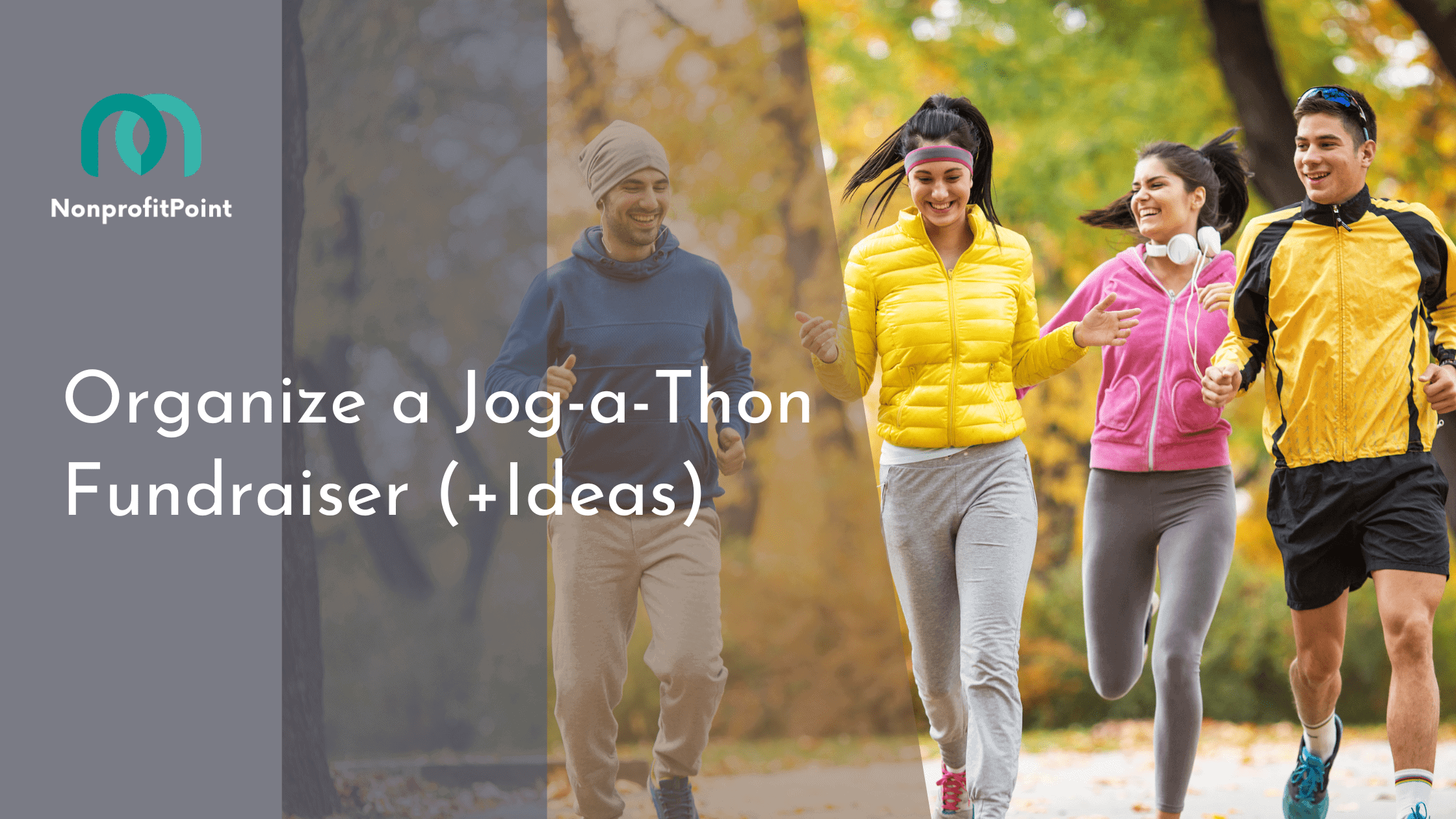10-Step Guide to Organize a Jog-a-Thon Fundraiser (+15 Ideas)
In the heart of every community lies the potential for collective action, and what better way to harness this energy than through a jog-a-thon fundraiser? This dynamic event not only brings people together for a noble cause but also emphasizes the importance of health and fitness in our lives. Whether you’re aiming to raise funds for a local school, a charitable organization, or a community project, a jog-a-thon offers a unique blend of community spirit and physical activity. It’s an opportunity to step outside, engage with neighbors, and make a tangible difference, all while enjoying the benefits of a good run or walk.
As we dive into the world of jog-a-thon fundraisers, remember that this is more than just an event; it’s a celebration of community resilience and the power of collective effort. You might be wondering how to get started, what creative ideas can make your event stand out, or how to maximize participation and fundraising. This blog post is designed to guide you through every step of the process.
From the initial planning stages to the final victory lap, we will provide practical tips, innovative ideas, and motivational insights to make your jog-a-thon a memorable and impactful event. So lace up your running shoes, and let’s embark on this journey together!
Here’s how you can organize a Jog-a-Thon Fundraiser (With Ideas):
- I. Introduction to Jog a Thon Fundraiser
- II. Setting Your Fundraising Goals
- III. Planning and Preparation
- IV. Designing the Course
- V. Registration Process
- VI. Fundraising Strategies
- VII. Marketing and Promotion
- VIII. Volunteer Coordination
- IX. Event Day Logistics
- X. Engaging the Community
- XI. Post-Event Activities
- 1. Color Run Jog-a-Thon
- 2. Pajama Dash
- 3. Superhero Sprint
- 4. Historical Figures Run
- 5. Pet-Friendly Jog-a-Thon
- 6. Glow-in-the-Dark Night Run
- 7. Silent Disco Run
- 8. Backward Jog-a-Thon
- 9. Eco-Friendly Green Run
- 10. Obstacle Course Jog-a-Thon
- 11. Virtual Jog-a-Thon
- 12. Decades Dash
- 13. Zombie Chase
- 14. Scavenger Hunt Run
- 15. High School Spirit Run
- Final Thoughts
I. Introduction to Jog a Thon Fundraiser

Imagine a sea of enthusiastic participants, of all ages and from all walks of life, lacing up their running shoes for a cause that’s close to their hearts. This is the essence of a jog-a-thon fundraiser, a popular community event where participants jog or walk a set course, usually collecting pledges for each lap completed or a flat donation amount.
The beauty of a jog-a-thon lies in its simplicity and inclusivity. It’s not just an athletic competition but a community gathering that celebrates health, perseverance, and the collective spirit of giving. This type of fundraiser is particularly effective because it appeals to a wide demographic – families, fitness enthusiasts, and anyone looking to support a good cause can participate.
It’s an event that combines the joy of physical activity with the powerful impact of community-driven fundraising, creating a ripple effect of positivity and engagement far beyond the day of the event.
II. Setting Your Fundraising Goals

Before diving into the logistics of organizing a jog-a-thon, it’s crucial to set clear, achievable fundraising goals. Start by identifying the primary purpose of your event. Are you raising funds for new school equipment, a local charity, or perhaps a community project? Understanding the ‘why’ behind your event will not only guide your planning process but also help you communicate your mission effectively to potential participants and donors. Next, establish a financial target.
This should be ambitious enough to inspire effort and participation, yet realistic considering your community’s size and resources. Consider previous fundraising efforts in your community as benchmarks. It’s also important to define how you’ll measure success.
While the total funds raised are a key indicator, don’t overlook other factors like participant engagement, community awareness, and the overall experience of volunteers and attendees. These elements are crucial for building a foundation for future events.
III. Planning and Preparation

The backbone of a successful jog-a-thon lies in meticulous planning and preparation. Begin by forming an organizing committee – a team of dedicated individuals who bring different skills and perspectives to the table. This committee will be responsible for making key decisions, delegating tasks, and ensuring that every aspect of the event is well-managed.
Selecting the right date and venue is critical. Choose a date that avoids conflicts with major community events or holidays, and ensure it gives you enough time for thorough preparation. The venue should be accessible, safe, and able to accommodate your expected number of participants. Public parks, school tracks, or community centers are often ideal choices.
Remember, hosting an event in public spaces may require permits and insurance, so make sure to investigate local regulations and requirements early in the planning process. This phase is also when you should start thinking about logistics like parking, restroom facilities, and first aid stations – aspects that are crucial for ensuring a smooth and safe event for everyone involved.
IV. Designing the Course

The course is the heart of your jog-a-thon, so designing it requires careful consideration. First, assess the expected number of participants and their age range. A course that’s too challenging may discourage novice runners or younger participants, while an overly simple route might not appeal to more seasoned athletes.
Ideally, the course should offer a balance, possibly with varying lap lengths or difficulty levels. Safety is paramount: ensure the path is clear of hazards, well-marked, and has enough space to prevent overcrowding. Accessibility is another key factor.
If possible, choose a route that accommodates wheelchairs and strollers to encourage wide participation. Additionally, consider the scenic value of your course. A route through a picturesque park or along a waterfront can greatly enhance the experience. Finally, make sure to have clear start and finish lines, and set up checkpoints along the route for water, first aid, and encouragement.
V. Registration Process
An efficient registration process is vital for a smooth-running event. Decide whether you’ll offer online, in-person, or both registration options. Online registration is convenient and can help you manage participant data effectively.
Use a reliable platform that can handle sign-ups, waivers, and payment processing. It’s important to set a participation fee that covers your costs but isn’t so high as to deter potential participants. Consider offering early bird rates or family discounts to encourage early and group signups.
Collecting participant data is crucial for planning and communication. Ensure your registration form captures essential information like contact details, t-shirt sizes (if providing event apparel), and any special needs. This data will also be valuable for future event planning and outreach.
VI. Fundraising Strategies
The fundraising strategy for your jog-a-thon should be multifaceted. The most common approach is to encourage participants to gather pledges for each lap they complete or to secure flat donations from friends, family, and colleagues. To maximize this, provide participants with easy-to-use tools and templates for soliciting pledges. Consider setting up an online platform where sponsors can make digital payments directly linked to participants’ efforts.
Additionally, think beyond just the running aspect for fundraising. You can organize side events like bake sales, raffles, or auctions on the day of the jog-a-thon. These not only raise additional funds but also add to the event’s appeal for those who may not wish to participate in the jog-a-thon itself. Engage local businesses by offering sponsorship opportunities.
In exchange for financial support or in-kind donations, businesses can receive advertising space on event materials, t-shirts, or banners. This not only helps offset your costs but also strengthens community ties. Remember, successful fundraising hinges on effective communication about your cause and the impact of the funds raised. Be transparent and regularly update participants and sponsors on the fundraising progress and the difference their contributions are making.
VII. Marketing and Promotion
Effective marketing and promotion are key to attracting participants and donors to your jog-a-thon. Start by crafting engaging promotional materials, including flyers, posters, and digital content for social media and email campaigns. Your messaging should highlight the purpose of the event, the fun and community aspects of participating, and how the funds raised will be used. Utilizing social media platforms is critical in today’s digital age.
Create event pages on Facebook, share updates on Instagram, and consider leveraging local community groups online to spread the word. Engaging content like participant stories, countdowns to the event, and information about the cause can help build excitement. Local media can be a powerful ally.
Reach out to local newspapers, radio stations, and community blogs with a well-crafted press release about your event. Highlight the uniqueness of your jog-a-thon and its benefit to the community to capture their interest. Lastly, don’t underestimate the power of word-of-mouth. Encourage everyone involved to share information about the event with their networks.
VIII. Volunteer Coordination
A strong team of volunteers is essential for a successful jog-a-thon. You’ll need people to help with various tasks such as setting up the course, registering participants, distributing water, and managing checkpoints. Start by recruiting volunteers from local schools, sports clubs, and community organizations. Once you have a team, assign roles based on individuals’ strengths and interests.
It’s important to have a clear communication plan for your volunteers. Organize briefing sessions to ensure everyone understands their roles and responsibilities. Provide them with all the necessary information, including schedules, maps of the course, and emergency procedures.
Remember, volunteers are the face of your event on the day, so their enthusiasm and engagement can greatly enhance the participant experience.
IX. Event Day Logistics
The success of the jog-a-thon hinges on the smooth execution of event day logistics. Early on the event day, set up the course with clear signage for the route, start and finish lines, and checkpoints. Make sure there’s an easily accessible and well-identified registration area for participants to check in. Safety should be your top priority.
Have a first aid station manned by qualified personnel and ensure that there are ample water stations along the course. Coordinate with volunteers to manage these stations and provide support to participants. Pay attention to small details like having enough trash bins to keep the venue clean. It’s also essential to have a contingency plan for unexpected issues like bad weather or medical emergencies.
Communication is key – ensure you have a way to convey important messages to participants and volunteers throughout the event, whether through public address systems, walkie-talkies, or mobile apps. After the race, have a plan for efficiently dismantling the setup and leaving the venue in good condition.
X. Engaging the Community
A jog-a-thon is not just a fundraiser; it’s a community event. To truly engage the community, reach out to local schools, clubs, and organizations to encourage participation. These groups can form teams, making the event more fun and competitive.
Involving local celebrities or public figures as participants or event ambassadors can also generate buzz and draw more attention. Think beyond the jog-a-thon itself by organizing family-friendly activities like face painting, music, or a post-event picnic.
These additional attractions can turn your fundraiser into a community festival, encouraging even non-runners to attend and participate. Building a sense of community spirit is essential. Highlight local stories, involve community leaders in the event, and create opportunities for participants to interact and connect. This not only enhances the experience but also strengthens the community’s bond, making them more likely to support future events.
XI. Post-Event Activities
Once the jog-a-thon is over, the work isn’t quite done yet. Acknowledging and thanking participants, volunteers, and sponsors is crucial. Consider sending thank you emails, certificates, or even small gifts to show your appreciation.
Publicly announce the amount raised and discuss the impact it will have on your cause. This not only brings closure to the event but also reinforces the positive feeling among participants and supporters. Gathering feedback is also important.
Conduct a survey or hold a debriefing meeting to collect insights on what went well and what could be improved. This feedback is invaluable for planning future events. Sharing photos and stories from the event on social media and with local media can help maintain the momentum and interest in your organization or cause.
Now let’s explore some Jog-a-Thon Fundraiser Ideas:
1. Color Run Jog-a-Thon
A Burst of Joy and Color: The Color Run Jog-a-Thon transforms the classic fundraiser into a kaleidoscope of fun. As participants run or walk the course, they are doused at various stations with non-toxic, biodegradable colored powder, creating a vibrant atmosphere that’s visually stunning and incredibly Instagram-worthy.
This playful twist appeals to all ages, encouraging families, youth groups, and even corporate teams to join in. The sheer joy of being covered in a rainbow of colors is a fantastic way to engage the community and attract media attention, which can be pivotal in maximizing your fundraising efforts.
Health and Happiness Combined: Beyond the aesthetic appeal, the Color Run also emphasizes a message of joy and inclusivity in physical activity. Unlike competitive races, the focus here is on fun and participation rather than speed or endurance. This inclusivity makes it particularly appealing to a wide demographic, including those who might be intimidated by more traditional running events.
To capitalize on the excitement, consider selling white t-shirts branded with your cause, which will turn into vivid souvenirs by the end of the run. Additionally, having a ‘color celebration’ party at the finish line with music, food stalls, and more color throws can turn the event into a full-fledged festival.
2. Pajama Dash
Comfort Meets Charity: The Pajama Dash offers a delightful twist to the jog-a-thon concept by inviting participants to run in their comfiest pajamas. This theme brings a sense of whimsy and relaxation to the event, making it highly attractive to families and children.
The laid-back atmosphere helps reduce the intimidation factor often associated with running events, making it more about community fun than athletic prowess. Encourage participants to show off their most fun or quirky pajamas, which can be a great conversation starter and a way to build a sense of camaraderie among participants.
Engagement and Excitement: To enhance the event, consider incorporating bedtime story themes or characters. You could set up themed zones along the route, each representing a popular children’s book or bedtime story, complete with decorations and costumed characters.
This not only adds an element of wonder and excitement but also encourages children to engage with literature and storytelling. After the run, a ‘bedtime snack’ area with healthy snacks, milk, and cookies could provide a perfect wind-down. This unique approach to a jog-a-thon is not just a fundraising event but a celebration of family, fun, and the joys of a good night’s sleep!
3. Superhero Sprint
Heroes Among Us: The Superhero Sprint is an opportunity for everyone to channel their inner hero. Participants dress up as their favorite superheroes, bringing a sense of empowerment and excitement to the event. This theme resonates especially well with children, but adults too find joy in the playful escape of embodying their favorite characters.
The visual spectacle of a crowd of superheroes running for a cause is not only exhilarating for participants but also an excellent photo opportunity for local media, giving your event added visibility.
Empowerment and Inspiration: The superhero theme naturally lends itself to a narrative of fighting for good, making it an ideal match for fundraising for causes like battling illnesses, supporting emergency responders, or helping underprivileged children.
To add depth to the event, consider featuring local heroes, such as firefighters or nurses, as honorary guests or race starters. This can be a powerful way to bridge the fictional world of superheroes with the real-life heroes in our communities. Adding a short ‘superhero training camp’ for kids before the run, with obstacle courses and fun challenges, can also be a great way to involve families and provide additional entertainment.
4. Historical Figures Run
A Run Through Time: The Historical Figures Run is a unique concept that combines fitness with education and creativity. Participants are encouraged to dress up as famous historical figures, turning the jog-a-thon into a lively, educational parade.
This theme is particularly appealing to schools and educational groups, as it encourages learning about history in an active and fun way. It also gives participants a chance to showcase their creativity and knowledge, possibly even inspiring others to learn more about the figures they represent.
Educational Engagement: To maximize the educational aspect, you could provide participants with information cards about their chosen historical figure to share with others during the run. Setting up themed water stations along the route, each representing different eras or significant historical events, can further enhance the educational experience.
Post-run activities could include a mini-fair where participants can learn more about various historical periods through interactive displays or short performances. This approach not only raises funds but also enriches the community’s knowledge and appreciation of history, making it a uniquely rewarding experience for all involved.
5. Pet-Friendly Jog-a-Thon
Paws on the Pavement: The Pet-Friendly Jog-a-Thon is a heartwarming event where participants can run or walk with their furry friends. This concept not only promotes health and fitness among community members but also celebrates the special bond between people and their pets.
It’s a fantastic way to include a wider audience, as pet owners are often looking for activities that they can enjoy with their four-legged companions. Additionally, this event can raise awareness about animal welfare and can be particularly effective if you’re raising funds for animal shelters or pet-related causes.
A Community of Pet Lovers: To make the event enjoyable and safe for both humans and pets, consider having different categories or lanes for various sizes and types of pets. You could also include fun competitions, like ‘best dressed pet’ or ‘pet-owner look-alike’ contests, adding an element of playful competition. Setting up pet-friendly water and snack stations along the route is essential.
Post-event, a ‘pet fair’ with booths for pet products, adoption services, and local veterinarians offering free check-ups or advice can turn the jog-a-thon into a comprehensive pet lovers’ gathering. This approach not only creates a fun day out for pet owners but also strengthens the sense of community among them.
6. Glow-in-the-Dark Night Run
A Night of Lights and Fun: The Glow-in-the-Dark Night Run adds a magical and exciting element to a traditional jog-a-thon. Held after sunset, the event is lit up with neon lights, glow sticks, and participants wearing reflective gear.
This visually stunning setup not only creates a unique running experience but also attracts a diverse crowd, including those who might not be interested in a typical daytime run. It’s a safe and festive way to enjoy the cooler evening hours, especially in warmer climates.
Illuminating the Cause: The glow-in-the-dark theme can symbolize ‘bringing light’ to the cause you’re supporting, making it especially relevant for fundraisers related to mental health awareness, education, or any cause that aims to ‘brighten’ lives.
Incorporating a pre-run party with glowing face paint stations, a DJ playing upbeat music, and glow-in-the-dark accessories for sale can enhance the festive atmosphere. Safety is key for a night event, so ensure the route is well-lit, and volunteers are present to guide and assist participants. This event promises not only a fun run but an unforgettable night experience.
7. Silent Disco Run
Dance Your Way to the Finish Line: The Silent Disco Run is a unique fusion of a fitness event and a dance party. Participants wear wireless headphones through which music is streamed, creating a personal yet shared musical experience.
This innovative concept is perfect for those who love music and dance, offering a fun twist to the conventional jog-a-thon. It’s an inclusive event where people of all fitness levels can enjoy the energy of a ‘party’ while engaging in physical activity.
A Symphony of Steps: The Silent Disco Run can cater to diverse musical tastes by offering different music channels on the headphones, allowing participants to select their preferred genre. This personalized aspect makes the event appealing to a broader audience.
Organize a pre-run dance warm-up session to get everyone in the mood and provide an opportunity for social interaction. Post-run, a silent disco party where participants can dance together, yet in their own musical world, can be a fantastic way to wind down. This event not only promotes fitness and fun but also emphasizes the power of music to bring people together.
8. Backward Jog-a-Thon
A Fun Twist on Running: The Backward Jog-a-Thon is exactly what it sounds like – participants run a portion of the race backward! This unusual concept adds a fun and challenging twist to the traditional jog-a-thon.
Running backward, also known as retro running, has been found to have unique health benefits, including improved balance and lower body strength. It’s a great conversation starter and offers a unique experience that participants are likely to remember and talk about.
Safety and Laughter Combined: Safety is crucial for an event like this. Ensure the backward route is short, free of obstacles, and possibly separate from the forward-running track to avoid collisions. Having spotters or volunteers along the route to guide runners is a good idea.
To add to the fun, consider incorporating light-hearted awards like ‘most graceful backward runner’ or ‘best backward running style.’ You can also blend in forward-running segments to give participants a break and vary their experience. This event is not just about running; it’s about having a laugh, trying something new, and stepping (or running) out of the usual comfort zone, all for a good cause.
9. Eco-Friendly Green Run
Run for the Environment: The Eco-Friendly Green Run is a jog-a-thon with a purpose to promote environmental awareness and sustainability. Participants are encouraged to wear recycled or eco-friendly attire, symbolizing their commitment to the planet. This theme is particularly impactful for raising funds for environmental causes, such as tree planting, wildlife conservation, or community gardens.
The event itself should embody eco-friendly practices, like using biodegradable cups at water stations, electronic registration to reduce paper use, and encouraging public transport or carpooling to the venue.
Sustainability in Action: To reinforce the green theme, the event can include educational booths or displays about environmental conservation, sustainable living tips, and local green initiatives. Partner with local environmental organizations or invite speakers to educate participants about eco-friendly practices.
Additionally, you could incorporate a clean-up run, where participants pick up litter along the course, combining fitness with community service. This type of jog-a-thon not only raises funds for a good cause but also actively contributes to making the environment cleaner and greener.
10. Obstacle Course Jog-a-Thon
A Challenge Beyond the Run: The Obstacle Course Jog-a-Thon adds an exhilarating twist by integrating various physical challenges along the running route. This can include hurdles, tire flips, crawl nets, and inflatable obstacles.
Such an event appeals to a wide audience, from fitness enthusiasts looking for a challenge to families seeking a fun and active day out. It’s an excellent way to break the monotony of a regular jog and add an element of playful competition.
Teamwork and Fun: Design the course to be suitable for different age groups and fitness levels, ensuring that everyone can participate safely and enjoyably. Encourage team participation, as obstacles can be a great way to promote teamwork and camaraderie.
Alongside the obstacle course, you could have a festival-like atmosphere with food stalls, music, and live demonstrations of fitness techniques or outdoor activities. This not only makes for an exciting event but also fosters a sense of community and shared accomplishment.
11. Virtual Jog-a-Thon
Running Without Borders: The Virtual Jog-a-Thon is a modern take on the traditional fundraising run, allowing participants to join from anywhere in the world. This format is incredibly flexible, as runners can complete their distance at a location and time of their choice, tracking their progress using fitness apps or smartwatches.
This type of event is ideal for engaging a wider audience, including those who cannot attend a physical event due to location, time constraints, or mobility issues.
Global Reach, Local Impact: Despite its virtual nature, it’s important to foster a sense of community and shared purpose. Use social media and online platforms to share progress, photos, and stories from participants worldwide.
You could even have a live online event before the run to motivate participants, share the cause, and build excitement. This global approach not only increases your fundraising reach but also raises awareness about your cause to a broader audience.
12. Decades Dash
A Jog Down Memory Lane: The Decades Dash is a nostalgic jog-a-thon where each section of the run represents a different decade, complete with music, fashion, and decorations from that era. Participants can dress up in vintage outfits, adding a fun and colorful element to the event.
This theme is particularly appealing as it resonates across generations, attracting a diverse range of participants, from young children to seniors.
Celebrating History and Culture: To enhance the experience, each decade station could offer a brief history or fun facts about the era, making it an educational journey through time. Collaborate with local schools or historical societies to create accurate and engaging displays.
After the run, host a retro-themed party with music and dance styles from various decades. This not only makes for a fun and educational event but also allows participants to connect with different periods, fostering a deeper appreciation for history and cultural evolution.
13. Zombie Chase
A Spooky and Spirited Run: The Zombie Chase Jog-a-Thon adds a thrilling twist to the usual run by incorporating elements of a playful chase. Participants can choose to be runners or zombies, with zombies gently tagging runners to symbolize a ‘catch’.
This theme brings an element of fun and fantasy to the event and is especially popular around Halloween. It’s a great way to attract a diverse crowd, including those who might not usually participate in a traditional jog-a-thon but are drawn to the playful, theatrical aspect of this event.
More Than Just a Run: To heighten the excitement, you can set up ‘safe zones’ along the route where runners can pause for a break from the zombies. For added fun, include makeup stations where participants can get their zombie transformations done by professionals.
This event isn’t just about the chase; it’s about immersing yourself in a different world, even if just for a few hours. The Zombie Chase can end with a ‘survivors’ party, where participants enjoy themed snacks and celebrate their escape.
14. Scavenger Hunt Run
A Race with a Twist of Mystery: The Scavenger Hunt Run combines the physical challenge of a jog-a-thon with the mental stimulation of a scavenger hunt. Participants complete a set running course, but along the way, they must find and collect specific items or complete certain tasks.
This format adds an element of strategy and fun, as participants need to balance speed with the need to thoroughly search for items or complete tasks.
Engaging Mind and Body: The scavenger hunt can be themed to match the cause you are supporting. For example, if the fundraiser is for a historical society, the items or tasks could be related to local history.
Clues and tasks should be challenging enough to be engaging but not so difficult that they become frustrating. The event could culminate in a gathering where participants share their findings and experiences, creating a sense of community and shared achievement.
15. High School Spirit Run
Uniting Through School Pride: The High School Spirit Run is an excellent way to involve local schools and foster a sense of community pride. Each school, class, or club can form teams, with participants wearing their school colors or mascots.
This theme is particularly effective in building a sense of unity and friendly competition among local schools and students. It’s also a great way to engage younger participants and instill in them a sense of community involvement and the importance of giving back.
Celebrating Education and Community: To amplify the school spirit, you could include categories for ‘most spirited team’ or ‘best team cheer’. Encourage schools to set up booths along the route where they can showcase their school activities, achievements, or unique programs.
This not only adds to the festive atmosphere but also provides schools with a platform to celebrate and promote their community contributions. The event can end with a school spirit celebration, where teams come together to celebrate their efforts, share their experiences, and enjoy entertainment and refreshments. This approach not only raises funds for a good cause but also strengthens the bonds within and between school communities.
Final Thoughts
In wrapping up your blog post, reflect on the success and impact of organizing a jog-a-thon fundraiser. Emphasize the dual achievements of promoting health and wellness and supporting a worthwhile cause. Encourage readers to consider the long-term benefits of such community events, not just in terms of funds raised but also in building stronger, healthier, and more connected communities.
Inspire them to take what they’ve learned and apply it to their fundraising efforts, whether by organizing their jog-a-thon or participating in one. The conclusion should leave readers feeling motivated and equipped with the knowledge to make a positive impact in their communities through such events.






